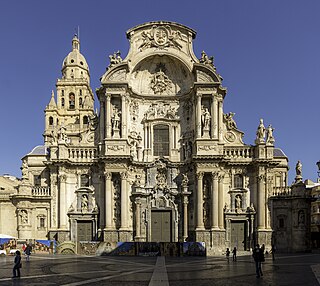
The Cathedral Church of Saint Mary in Murcia, commonly called the Cathedral of Murcia, is a Catholic church in the city of Murcia, Spain. It is the cathedral of the Roman Catholic Diocese of Cartagena.

The Augustinian Church in Vienna is a parish church located on Josefsplatz, next to the Hofburg, the winter palace of the Habsburg dynasty in Vienna. Originally built in the 14th century as the parish church of the imperial court of the Habsburgs, the harmonious Gothic interior was added in the 18th century. The official name of church and parish is St. Augustin, but it is locally called Augustinerkirche.

Amorbach Abbey was a Benedictine imperial abbey of the Holy Roman Empire located at Amorbach. It was later the residence of the rulers of the short-lived Principality of Leiningen, before that became part of the Kingdom of Bavaria, and its historic buildings still belong to the princely family.

The Theatine Church of St. Cajetan and Adelaide is a Catholic church in Munich, southern Germany. Built from 1663 to 1690, it was founded by Elector Ferdinand Maria and his wife, Henriette Adelaide of Savoy, as a gesture of thanks for the birth of the long-awaited heir to the Bavarian crown, Prince Max Emanuel, in 1662. Now administered by the Dominican Friars, it is also known as the Dominican Priory of St. Cajetan.
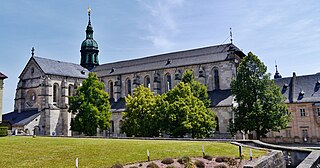
Ebrach Abbey is a former Cistercian monastery in Ebrach in Oberfranken, Bavaria, Germany, now used as a young offenders' institution.

Wilhering Abbey is a Cistercian monastery in Wilhering in Upper Austria, about 8 km (5 mi) from Linz. Stift Wilhering is the oldest Cistercian monastery in Upper Austria. The buildings, re-constructed in the 18th century, are known for their spectacular Rococo decoration.
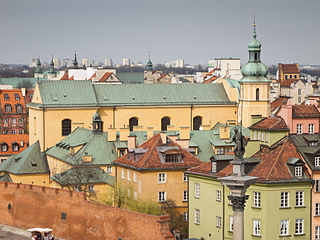
St. Martin's Church is a church in Warsaw, Poland. It is located on ulica Piwna in the Polish capital's Old Town.
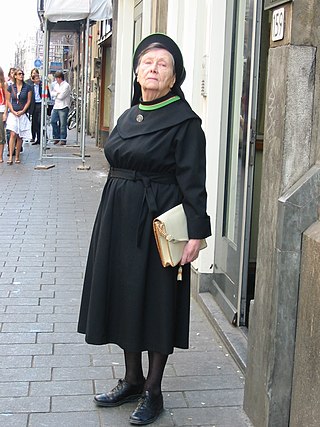
Augustinian nuns are the most ancient and continuous segment of the Roman Catholic Augustinian religious order under the canons of contemporary historical method. The Augustinian nuns, named after Saint Augustine of Hippo, are several Roman Catholic enclosed monastic communities of women living according to a guide to religious life known as the Rule of St. Augustine. Prominent Augustinian nuns include Italian mystic St. Clare of Montefalco and St. Rita of Cascia.

The Roman Catholic church of St. Mary Magdalene in Lviv, Ukraine, is located west of the city's Old Town, by the Lviv Polytechnic.

Oliwa, Gdańsk Archcathedral is a church in Oliwa, Gdańsk, Poland that is dedicated to the Holy Trinity. Also known as the Archcathedral Basilica of the Holy Trinity in Oliwa, Gdańsk.

The Augustinian Church, also called the Augustinian Abbey (Augustinerkloster) or Abbey Church of St John the Baptist and John the Evangelist is a former church in Munich, Germany. Constructed during the 13th century and expanded during the next two centuries, it was the Abbey Church of the Augustinian hermits in the city.

The Peruvian colonial architecture, developed in the Viceroyalty of Peru between the 16th and 19th centuries, was characterized by the importation and adaptation of European architectural styles to the Peruvian reality, yielding an original architecture.

The Santa Monica Parish Church, commonly known as the Minalin Church, is a Baroque church, located in poblacion area of San Nicolas in Minalin, Pampanga, Philippines. The church, built during the Spanish era, was declared a National Cultural Treasure by the National Commission for Culture and the Arts and the National Museum of the Philippines on August 27, 2011, one of 37 churches in the country bestowed that honor.

St. Andrew’s Church is a Catholic church in Antwerp built in the 16th century. Its exterior is mainly characterised by a late-Gothic style while its interior is predominantly executed in Baroque style. It is the parish church of the Parish of St. Andrew’s. During the nineteenth century the St. Andrew's Parish was known as the parish of misery as it was by then mainly populated by poor people.

The Église Saint-Ferréol les Augustins is a Roman Catholic church in Marseille.
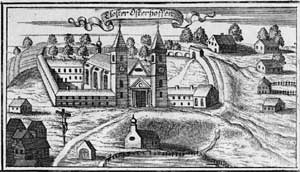
Osterhofen Abbey is a former monastery in Bavaria, Germany, It is located in the Altenmarkt section of Osterhofen, a town to the south of the Danube between Deggendorf and Vilshofen / Passau. It has its origins in a collegiate built in 1004–09. From 1128 to 1783 it was a Premonstratensian monastery. For a while it was then a convent. Today it contains a girls' secondary school. The former abbey church, a magnificent late baroque building erected in 1726–40, is now the Basilica of Saint Margaret.

The Church of St Augustine is a Roman Catholic church building in Victoria, Gozo, Malta, situated in St Augustine's Square. The church is part of the Augustinian monastery situated on its left side.

Augustinerkirche was once one of the five main churches in the old town of Zürich, Switzerland, together with Fraumünster, Grossmünster, Predigern and St. Peter's. First built around 1270 as a Romanesque church belonging to the Augustinian abbey, on occasion of the Reformation in Zürich worship in the church was discontinued. The present Christian Catholic Church community of Zürich planned to rebuild the building to commemorate the old Augustinian church, and for the same reason, Augustinerkirche is still their Parish church, that was rebuilt in 1843/44 by Ferdinand Stadler. In the late 1950s, the church was rebuilt in accordance with the plans for the original structure. Today the building is one of the three medieval churches in the Lindenhof district of the city of Zürich.

Liebfrauenkirche is a Gothic-style Catholic parish church, located in the centre of Frankfurt, Germany. It was built in several phases from the 14th to the 16th century and serves today as a monastery church. Close to the shopping district, it serves as a place of rest even to visitors who are not religious. With an organ completed in 2008, it is a major venue for church music events.

The Reglerkirche is a church building in the historical centre of Erfurt in Thuringia, Germany. It serves a Lutheran parish as a place of worship and is one of the larger churches in the city's old part. In times of East Germany, it was considered a centre of church music in Erfurt.
























